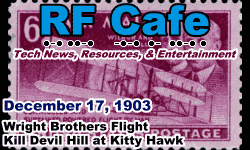|
 December 17 December 17
 1797:
Joseph Henry,
discoverer of the principle of self-induction, and after whom the unit of inductance
is named, was born. 1861: Co-discoverer of the radio reflecting properties of the
ionosphere in the upper atmosphere (the
Kennelly-Heaviside
layer), and first to apply complex number analysis to AC circuits,
Arthur
Kennelly, was born. 1880: The
Edison Electric Illuminating Company of NY was incorporated for
the purpose of providing electric light to New York City. 1892:
George Brayton,
who invented the first commercially produced
internal combustion engine and developed the
Brayton cycle,
died. 1903: Near Kitty Hawk,
NC, the Wright Brothers, with Orville at the controls, made the first
recorded flight in their self propelled, heavier than air machine called the
Wright B Flyer. 1907:
Lord Kelvin,
after whom the absolute temperature scale is named, died. 1908: American chemist
Willard Libby, who won the Nobel Prize for his development of
carbon-14 dating, was born. 1969: The U.S. Air Force closed its Project "Blue
Book" by concluding there was no evidence of extraterrestrial spaceships to
support the thousands of claimed UFO sightings. 1974: The millionth trademark was
registered. 1797:
Joseph Henry,
discoverer of the principle of self-induction, and after whom the unit of inductance
is named, was born. 1861: Co-discoverer of the radio reflecting properties of the
ionosphere in the upper atmosphere (the
Kennelly-Heaviside
layer), and first to apply complex number analysis to AC circuits,
Arthur
Kennelly, was born. 1880: The
Edison Electric Illuminating Company of NY was incorporated for
the purpose of providing electric light to New York City. 1892:
George Brayton,
who invented the first commercially produced
internal combustion engine and developed the
Brayton cycle,
died. 1903: Near Kitty Hawk,
NC, the Wright Brothers, with Orville at the controls, made the first
recorded flight in their self propelled, heavier than air machine called the
Wright B Flyer. 1907:
Lord Kelvin,
after whom the absolute temperature scale is named, died. 1908: American chemist
Willard Libby, who won the Nobel Prize for his development of
carbon-14 dating, was born. 1969: The U.S. Air Force closed its Project "Blue
Book" by concluding there was no evidence of extraterrestrial spaceships to
support the thousands of claimed UFO sightings. 1974: The millionth trademark was
registered.
| 100th Anniversary of Flight |
| On this date in 1903, at Kill Devil Hills, N.C., Orville Wright,
winning a coin toss, piloted the airplane that he and his brother, Wilbur, designed
and built to make the world's first controlled, heavier-than-air flight in a self-powered
aircraft. The flight covered 120 feet in 12 seconds. The fourth and last of that
day lasted 59 seconds for 852 feet. |
| The Wrights conducted hundreds of tests using kites and gliders
to develop the design for the 1903 Flyer. The wingspan steadily grew, from 5 feet
for their 1899 biplane kite, to 17½ feet for the 1900 glider, to 22 feet in 1901,
to 32 feet in 1902, and finally to more than 40 feet for the first powered airplane. |
| The Flyer used a simple three-axis steering system that controlled
pitch, roll and yaw. The custom-built 4-cylinder, 12-HP engine had no spark plugs,
carburetor, fuel pump or water pump, and weighed 200 lbs. Wind tunnels were built
to test their airframe and control theories. |
| To this day there are people who claim the Wrights were beaten
to the record, but no credible witnesses have ever justified any of them. Even Samuel
Langley, then the head of the Smithsonian Institute, battled the brothers to the
point that they originally placed their Flyer in an English museum instead of his.
Please, no e-mails with supporting evidence ;-) |
| The Wright Experience
National
Air & Space Museum
NASA - The Wright Way
U.S. Centennial of
Flight Commission
First Flight Centennial
Wright Brothers Aeroplane
Company
Current Aeronautical Weather
|
|
| Jan
| Feb | Mar |
Apr | May |
Jun | Jul |
Aug | Sep |
Oct | Nov |
Dec |
Note: These
historical tidbits have been collected from various sources, mostly on the Internet.
As detailed in
this article, there
is a lot of wrong information that is repeated hundreds of times because most websites
do not validate with authoritative sources. On RF Cafe, events with
hyperlinks have been verified. Many years ago,
I began commemorating the birthdays of notable people and events with
special RF Cafe logos.
Where available, I like to use images from postage stamps from the country where
the person or event occurred. Images used in the logos are often from open source
websites like Wikipedia, and are specifically credited with a hyperlink back to
the source where possible.
Fair Use laws permit
small samples of copyrighted content.
|
 December 17
December 17